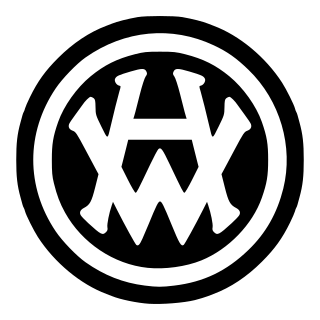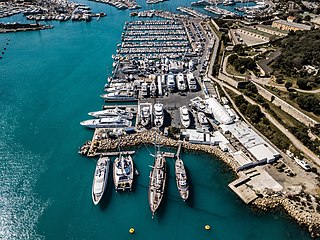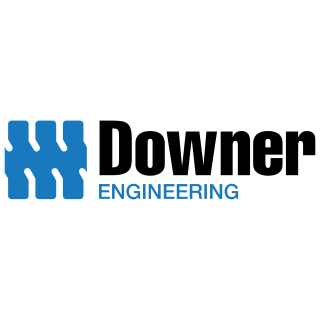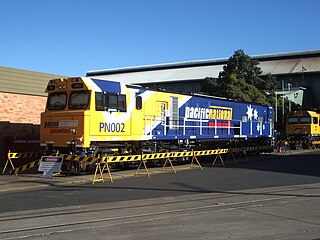
Harland & Wolff is a British shipbuilding and fabrication company headquartered in London with sites in Belfast, Arnish, Appledore and Methil. It specialises in ship repair, shipbuilding and offshore construction. Harland & Wolff is famous for having built the majority of the ocean liners for the White Star Line, including Olympic-class trio – RMS Olympic, RMS Titanic and HMHS Britannic. Outside of White Star Line, other ships that have been built include the Royal Navy's HMS Belfast; Royal Mail Line's Andes; Shaw, Savill & Albion's Southern Cross; Union-Castle's RMS Pendennis Castle; P&O's Canberra; and Hamburg-America's SS Amerika of 1905. Harland and Wolff's official history, Shipbuilders to the World, was published in 1986.

A shipyard, also called a dockyard or boatyard, is a place where ships are built and repaired. These can be yachts, military vessels, cruise liners or other cargo or passenger ships. Compared to shipyards, which are sometimes more involved with original construction, dockyards are sometimes more linked with maintenance and basing activities. The terms are routinely used interchangeably, in part because the evolution of dockyards and shipyards has often caused them to change or merge roles.

Kangaroo Point is an inner southern suburb in the City of Brisbane, Queensland, Australia. In the 2021 census, Kangaroo Point had a population of 9,689 people.

Downer Group is an integrated services company active in Australia and New Zealand.

John Brown and Company of Clydebank was a Scottish marine engineering and shipbuilding firm. It built many notable and world-famous ships including RMS Lusitania, RMS Aquitania, HMS Hood, HMS Repulse, RMS Queen Mary, RMS Queen Elizabeth and Queen Elizabeth 2.

Downer Rail is a business unit within the Downer Group. As well as manufacturing and maintaining railway rolling stock it holds maintenance contracts to maintain rail infrastructure. The head office is located in North Ryde.
Alexander Stephen and Sons Limited, often referred to simply as Alex Stephens or just Stephens, was a Scottish shipbuilding company based in Linthouse, Glasgow, on the River Clyde and, initially, on the east coast of Scotland.

Tenix is a privately owned Australian company involved in a range of infrastructure maintenance and engineering products and services to the utility, transport, mining and industrial sectors in Australia, New Zealand, the Pacific Islands, and the United States.

Walkers Limited was an Australian engineering and shipbuilding company based in Maryborough, Queensland. It built large vessels and railway locomotives. The Walkers factory still produces locomotives and rolling stock as part of Downer Rail.

Titan Clydebank, more commonly known as the Titan Crane is a 150-foot-high (46 m) cantilever crane at Clydebank, West Dunbartonshire, Scotland. It was designed to be used in the lifting of heavy equipment, such as engines and boilers, during the fitting-out of battleships and ocean liners at the John Brown & Company shipyard. It was also the world's first electrically powered cantilever crane, and the largest crane of its type at the time of its completion.

Clyde Engineering was an Australian manufacturer of locomotives, rolling stock, and other industrial products.

The GT42CU AC is a model of diesel electric locomotives manufactured by EDi Rail, Maryborough between 1999 and 2005 under licence from Electro-Motive Diesel, for use on narrow gauge railways in Queensland.
There have been several proposals and studies for a project to build a replica ship based on the famous Olympic-class ocean liner, RMS Titanic. A project by South African businessman Sarel Gaus was abandoned in 2006, and a project by Australian businessman and former politician from Fairfax division Clive Palmer was announced in 2012, known as the Titanic II. While Palmer has made no official announcement about his project being abandoned, it appears to have seen a dramatically decreased amount of progress by 2015 and no construction. A Titanic replica to be permanently docked at an inland resort in Sichuan, China commenced construction in May 2015. The Titanic Museums in Branson, Missouri and Pigeon Forge, Tennessee are designed to depict the forward half of the Titanic.

South Brisbane Dry Dock is a heritage-listed dry dock at 412 Stanley Street, South Brisbane, City of Brisbane, Queensland, Australia. It was designed by William David Nisbet and built from 1876 to 1887. It is also known as the Government Graving Dock. It was added to the Queensland Heritage Register on 21 October 1992.

The 1200-ton Oil Fuel Lighter was a class of oil fuel lighters built for the Royal Australian Navy between 1940 and 1946.

The Aboriginal Centre for the Performing Arts (ACPA) is a national Australian institution for the culturally sensitive training of Aboriginal Australian and Torres Strait Islander people in the performing arts. Founded in 1997, it has been located in Fortitude Valley, Brisbane, since 2017.
Douglas John Sherrington was a member of the Queensland Legislative Assembly.

The Cairncross Dockyard was a shipyard beside the Brisbane River at 405 Thynne Road, Morningside, City of Brisbane, Queensland, Australia. It included one of Australia's largest graving docks with an 8.5 metre deep water access, capable of taking Panamax vessels of up to 85,000 dwt, up to 263 metres long x 33.5 metres wide. It is second in size only to the Royal Australian Navy's Captain Cook Graving Dock in Sydney.

















